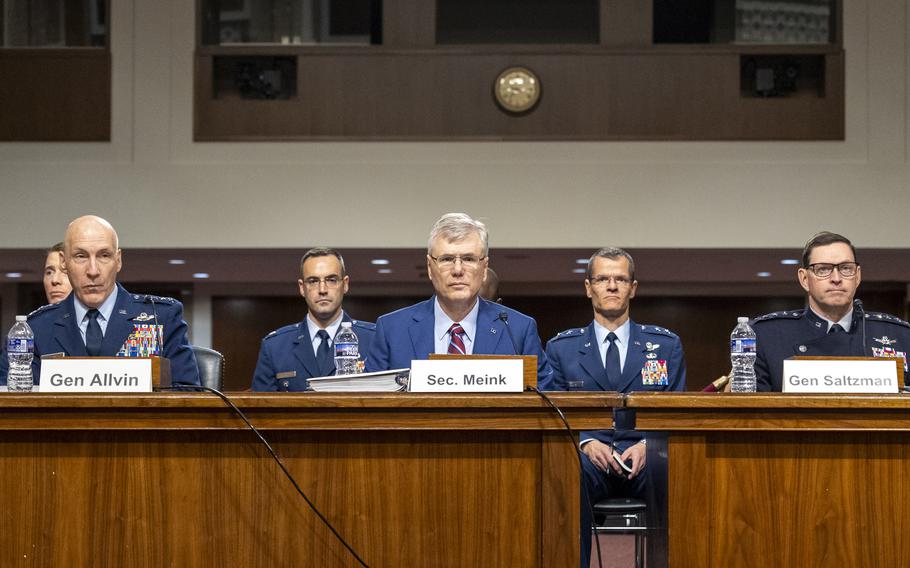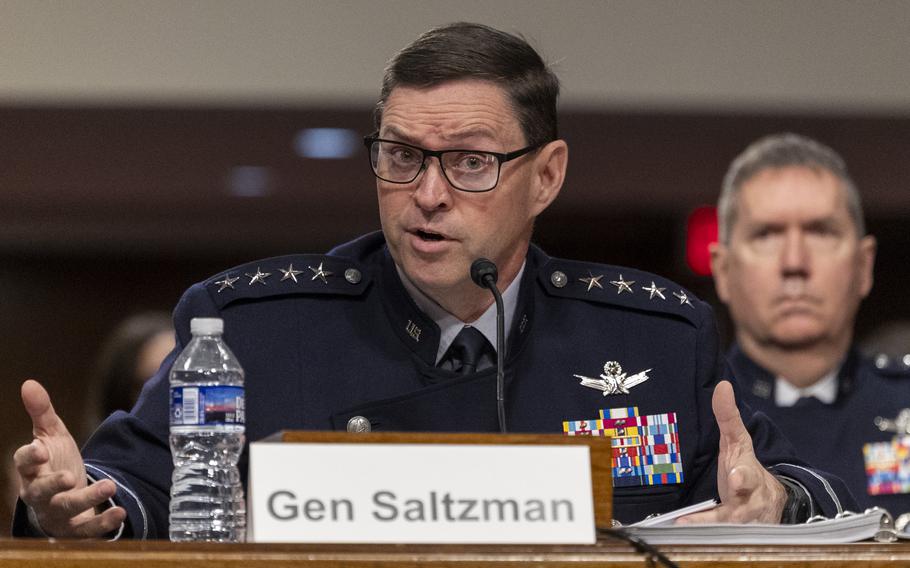
Air Force Chief of Staff Gen. David W. Allvin, left, Secretary of the Air Force Troy Meink, and Space Force Chief of Space Operations Gen. Chance Saltzman prepare to testify Tuesday, May 20, 2025, at a Senate Armed Services Committee hearing in Washington. (Eric Kayne/Stars and Stripes)
WASHINGTON — The Space Force is losing nearly 14% of its civilian workers to a combination of early retirements, resignations and other incentives as the Defense Department works to slash its civilian workforce.
The downsizing is hitting the Space Force, which depends on civilians for one-third of its 17,000-person force, particularly hard, Gen. Chance Saltzman, chief of space operations, said on Tuesday.
“We understand the desire to reduce the civilian workforce. It’s just having a little bit of an outsized impact on the Space Force,” he told the Senate Armed Services Committee, later adding that even a 10% reduction is a “large hit.”
Many of the civilians who work for the service, the youngest and smallest military branch, have highly technical skills and provide expertise that the Space Force does not have among its active-duty service members, Saltzman said.
They “bring corporate continuity across all of our processes and procedures,” he said, and are essential to the acquisition of systems at a time when the Space Force is being asked to take on new responsibilities and missions, including the Golden Dome missile defense program.

Space Force Chief of Space Operations Gen. Chance Saltzman testifies Tuesday, May 20, 2025, at a Senate Armed Services Committee hearing in Washington. (Eric Kayne/Stars and Stripes)
“We rely heavily on our civilian workforce,” Saltzman said. “I’m worried about replacing that level of expertise in the near term as we try to resolve it and make sure we have a good workforce doing that acquisition work.”
The Defense Department is aiming to cut 5% to 8% of its 900,000 civilian employees, which could ultimately affect more than 70,000 people.
About 21,000 Pentagon employees volunteered for deferred resignations offered by the Office of Personnel Management earlier this year and tens of thousands more have taken up other incentives to leave offered by the Defense Department.
The Army has seen 16,000 civilians sign up for deferred resignations, the Air Force is poised to lose 12,000 civilians, the Navy will shed 10% of its civilian personnel and the Marine Corps is expecting 1,600 resignations, according to testimony provided by personnel chiefs last month.
By the end of 2025, the Space Force was supposed to have a civilian workforce almost 1,000 people larger than it will end up being due to the reductions, Saltzman said.
The service had been in a “period of managed growth,” trying to increase the number of its civilian personnel to fill a deficit before being asked to stop that growth and offer early retirements and resignations, he said.
The shifting policies have led to a suspension of hiring for several missions, including cyber defense, “until we figure out exactly what the size of the civilian workforce is going to be,” Saltzman said.
“As soon as I understand what that size is, then we will redistribute and reallocate the civilian workforce as necessary,” he told senators.
Lawmakers have repeatedly raised concerns about the reductions.
Sen. Jack Reed of Rhode Island, the top Democrat on the Senate Armed Services Committee, urged Saltzman and other service heads on Tuesday to alert Congress if they see the civilian workforce reach a “point of breaking.”
“We’re not going to do all these great scientific and developmental and modernization issues without these critical workers,” he said.
The Space Force in the past three years has accepted several new missions, including the development of satellites to track moving targets on the ground and in the air, according to Saltzman.
Its newest task is proving the space-based technology needed for the Golden Dome, a system ordered by President Donald Trump to detect, track and potentially intercept incoming missiles. The project will heavily depend on the Space Force’s sensors, data fusion and communication capabilities, Saltzman said.